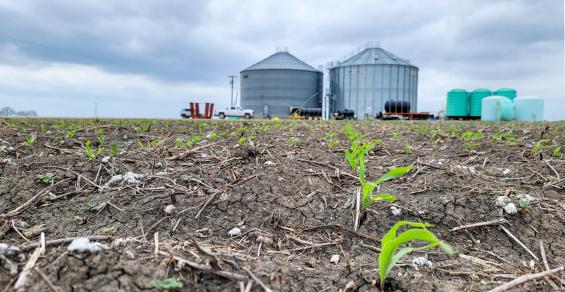Rain received on the Texas Blacklands last week will help finish out this season’s wheat crop and aid in corn and cotton plant growth.
“Rust in wheat is picking up across the area after the recent rains and will likely continue to spread for the next few days,” says Texas A&M AgriLife Extension IPM Agent Tyler Mays, Hill and McLennan counties, in the recent issue of Blacklands IPM Update.
Despite starting the season dry, the region’s corn crop is progressing well, Mays says. “The bright side of low spring rains is it caused the plant roots to dig deep into the soil for moisture. These deep-rooted corn plants will be less susceptible to moisture stress later this summer as they can access what deep soil moisture we have and that may build up in the coming months.”
See, Lower Rio Grande Valley receives much-needed rainfall
Cotton planting in the area is complete with a few producers still replanting fields where there was poor emergence on the initial crop. “Emergence issues are evident in just about every field I have looked at,” Mays says. “Some are worse than others, and it appears to be more of a soil moisture issue than variety. Thankfully, insect pest issues, at this time, are not a major concern but we do need to keep our eyes on the thrips populations, aphids, and spider mites which I can find in every field I have scouted.”
Weeds are beginning to emerge following the recent rain event. “The next few days will be the optimal time for herbicide applications, so you can treat the weeds before they get too tall and hard to control.”
Wheat
If rainfall continues, leaf rust will continue to spread in untreated wheat fields. “We are getting to
the point in the growing season where fungicides are no longer labeled for application based on the crop’s growth stage and the amount of yield loss from leaf rust is minimal due to the growth stage,” Mays says. ” Most of the wheat I am looking at was in the soft dough stage this week and will likely be in the hard kernel stage within the next 10 days.”
See, Central Texas producers further tighten economic belt
Mays says leaf rust yield loss is dependent on the percent of the flag leaf infected and the growth stage. “When wheat is in the soft dough stage, yields can be reduced by 1% for every 10% of the flag leaf infected, so if roughly 70% of the flag leaf is infected with leaf rust at the soft dough stage there will be about a 7% yield loss (Table 1). If wheat has not reached the soft dough stage, it may be beneficial to evaluate and treat with a fungicide if leaf rust is likely to infect the flag leaf.”
Insect populations are low. As he scouts fields, Mays says he’s spotted stink bugs and grasshoppers. “Wheat fields should continue to be monitored,” Mays says. “Stink bugs are feeding on the developing heads and can lead to decreased kernel weights. The economic threshold for stinkbugs in wheat is not set in stone, but it is recommended to spray when there is one stinkbug in 10 heads from flowering through the milk stage and when there are three stinkbugs in 10 heads from the dough stage to the hard kernel stage.”
Cotton
Cotton has emerged and is in a good stage considering the weather patterns the region experienced leading up to planting, Mays says. “There are some emergence issues as you move west and south in the area which did not receive as much rain as areas east of I-35 and North of Hillsboro before planting cotton. The recent rains should help those seeds that are still viable to emerge.”
Seed viability in fields planted three weeks ago is becoming a big concern, adds. “If you have poor stands, I would wait until Tuesday (May 3) to start evaluating your stands, as this will give those seeds plenty of time to emerge if they are still viable. When evaluating stands, look at both the number of plants per acre and the uniformity of the stand in hopes having skips no bigger than 1.5 feet between plants. “
Scouting fields, Mays has found thrips, aphids, and spider mites but says they are below economic threshold. “Thrips (Figure 1) are averaging less than one thrip per true leaf, and most I’m seeing are adults indicating that our insecticide seed treatments are still working. However, these insecticide seed treatments start playing out as you get to the 2 to 3 true leaf stage.”
So far this year, thrips populations have not been as bad as in recent years. Mays credits this to later-maturing wheat. “Thrips are not migrating out of area wheat fields yet.”
Populations are also reduced because wildflowers in roadside ditches are attractive to a lot of western flower thrips. “As these flowers start dying off or we start mowing roadside ditches they will quickly move into cotton fields to feed on the young tender tissue.”
Walking cotton fields, the leaves appear to have thrip damage, Mays says, but in most cases it’s likely wind damage. “If we do get into a situation where we need to start spraying for thrips, they are easy to manage and there are several chemicals on the market that we recommend including acephate, dicrotophos (Bidrin), spinetoram, and dimethoate, if you can find them.”
Now that the region has received much-needed rainfall, IPM Agent encourages producers to watch for rust, thrips and weed pressure.




